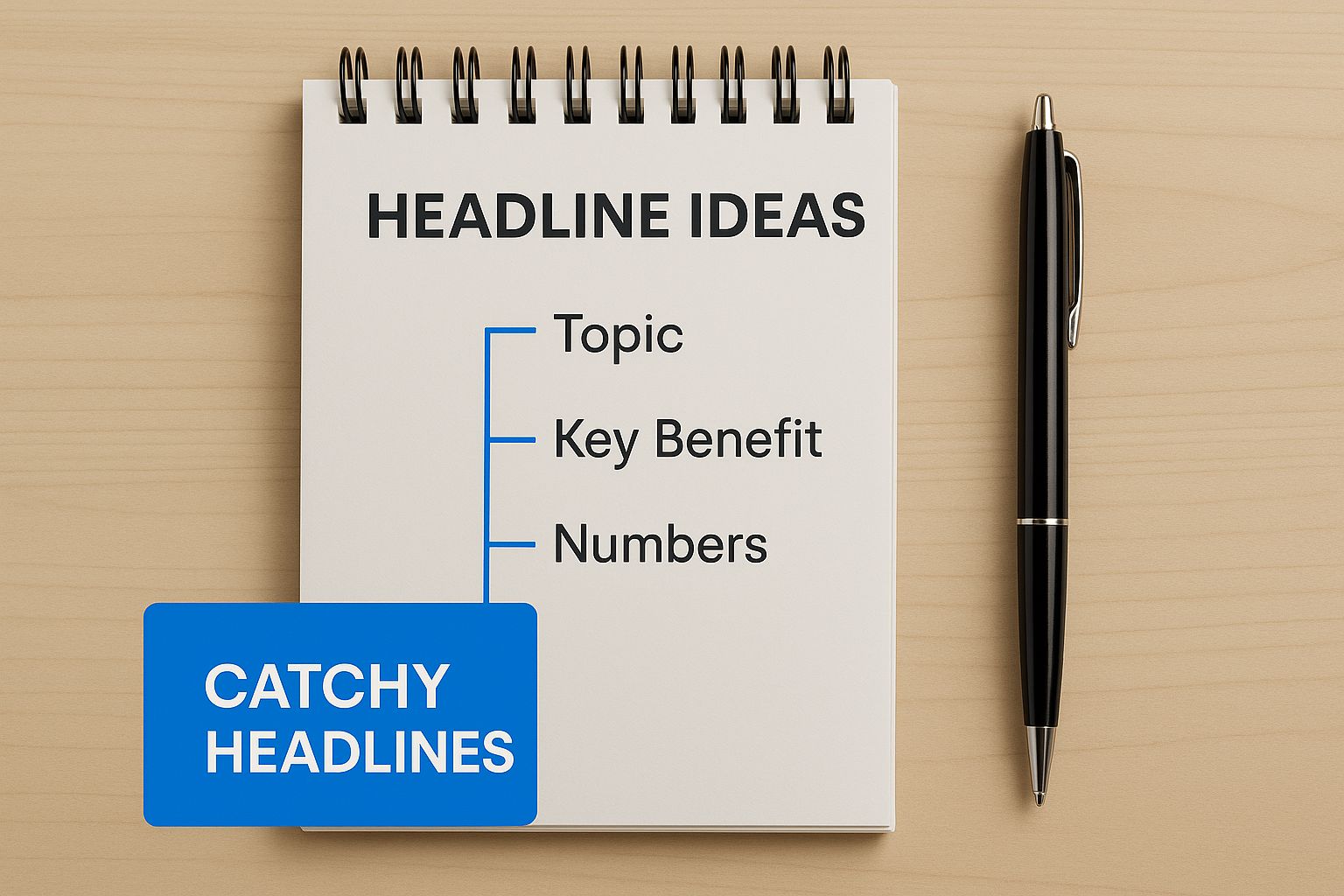Copywriting For Dummies A Practical Guide

Copywriting isn't about stringing together fancy words. At its core, it's about using words to persuade someone to take a specific action, like buying a product or signing up for a newsletter.
A great way to think about it is as salesmanship in print. It’s the engine running behind every ad, website, and email that ultimately convinces you to click, buy, or subscribe.
What Is Copywriting and Why Does It Matter?
Let's cut through the noise. Copywriting isn't about crafting complicated, academic-sounding sentences. It's about starting a conversation with a crystal-clear goal in mind.
The best copy feels like a friendly, persuasive guide. It meets customers where they are and shows them exactly how a product or service can solve their specific problem. It's really an art form that blends empathy, strategy, and clear communication into one powerful skill.
You see copywriting in action all day long, even if you don't notice it.
- Emails: That subject line you just couldn't resist clicking? Copywriting. The message inside with a deal that felt too good to pass up? Also copywriting.
- Websites: The headline that immediately grabbed your attention and the button that nudged you to "Learn More." Yep, that's it too.
- Social Media Ads: The short, punchy text that made you stop scrolling and check out a brand you'd never heard of before.
The Growing Demand for Good Copywriting
Getting a handle on this is your first step toward writing words that do more than just sit on a page—they get results. And this isn't just some niche skill; it's absolutely critical for modern business and marketing.
In fact, its importance is backed by some serious numbers. The global copywriting services market was valued at a whopping $25.29 billion in 2023 and is on track to hit $42.22 billion by 2030. That kind of growth shows just how much businesses are willing to invest in persuasive writing to get ahead. You can dig into more data on these copywriting trends to see the full picture.
Good copywriting isn’t about tricking people. It’s about showing them a solution they were already looking for, using language that connects with them on a personal level.
Ultimately, mastering the basics of copywriting means learning how to truly connect with an audience. When you understand their needs and speak their language, you can create messages that don't just capture their interest—they inspire real, meaningful action. That makes it an invaluable skill in just about any industry.
Unlocking The Psychology Of Persuasive Copy
Here's a secret every seasoned copywriter knows: great copy isn't about stringing together impressive words. It's about psychology. It’s about truly understanding what makes people pause, think, and ultimately, act.
To write copy that actually sells, you have to get out of your own head and into your customer's. This means shifting the entire conversation away from what your product is and focusing entirely on what it does for them.
Think about it. Nobody wakes up wanting to buy a drill. They want a hole in the wall to hang a picture of their family. That feeling—the warmth of seeing a cherished memory on display—is the real motivation. This is the crucial difference between features and benefits.
From Features To Benefits
Getting this distinction right is a game-changer, especially when you're just starting out. A feature is a cold, hard fact about a product. A benefit is the emotional payoff for the customer. It answers their unspoken question: "What's in it for me?"
Let's break this down with a few examples.
| Product Feature (What it is) | Customer Benefit (What it does for you) |
|---|---|
| A camera with a 50MP sensor | Capture crystal-clear photos to preserve your precious memories forever. |
| A laptop with a 15-hour battery | Work from anywhere without constantly searching for a power outlet. |
| Water-resistant running shoes | Keep your feet dry and comfortable, no matter the weather. |
Your main job as a copywriter is to act as a translator. You take every feature and turn it into a compelling, emotional benefit that your reader can see, feel, and desire.
Create Your Customer Avatar
So, how do you write benefits that actually hit the mark? You have to know exactly who you're talking to. This is where a customer avatar comes in—it’s a detailed profile of your one, perfect customer. Forget basic demographics; we're going deeper.
A customer avatar helps you step into your audience's shoes. You learn their biggest fears, deepest desires, and daily frustrations. This empathy is the secret ingredient to copy that feels personal and compelling.
To truly connect, you need to dig into effective audience research methods. This deep knowledge allows you to craft a powerful unique value proposition (UVP). Your UVP is a clear, concise statement that instantly answers, "Why should I choose you over anyone else?"
When you know your customer inside and out, your writing stops sounding like a sales pitch. It becomes a helpful conversation. And that’s when the real persuasion happens.
Proven Frameworks To Structure Your Copy
Staring at a blank page is intimidating. We’ve all been there. But you don’t have to pull brilliant copy out of thin air every single time. Smart copywriters rely on proven frameworks—think of them as recipes for persuasion that give your writing a clear, effective structure.
These are essentially plug-and-play models that take the guesswork out of the process. Instead of wondering what to say next, you have a time-tested blueprint that guides your reader from one point to the next without a hitch.
Coming up with a catchy headline is a great start, but it's just the first step. The real magic happens when you build that idea into a structured narrative, just as the image below suggests.
Even the most creative ideas need a solid foundation to work, and that’s exactly what these frameworks provide.
The PAS Framework: Problem, Agitate, Solution
One of the simplest yet most powerful frameworks is PAS (Problem, Agitate, Solution). It’s a classic for a reason. It works by tapping directly into your reader’s deepest pain points, showing them you understand, and then positioning your offer as the ideal fix.
Here’s the breakdown:
- Problem: Start by clearly identifying a problem your audience faces.
- Agitate: Don’t just state the problem—twist the knife a little. Describe the frustration, annoyance, and negative feelings it causes. Make it real.
- Solution: Step in as the hero and introduce your product or service as the clear, logical answer to that very specific pain.
For a project management tool, it might look like this: “Tired of missing deadlines again? It’s beyond frustrating when crucial tasks slip through the cracks, leading to team stress and unhappy clients. Our tool keeps everything organized in one place, so you nail your targets every single time.”
The AIDA Framework: Attention, Interest, Desire, Action
Another giant in the copywriting world is AIDA (Attention, Interest, Desire, Action). This model is perfect for mapping out the entire customer journey, from the first glance to the final click. You see it everywhere, from email campaigns to high-converting landing pages.
AIDA is brilliant because it builds momentum. Each step flows logically into the next, gently guiding the reader toward your call to action without ever feeling aggressive or pushy.
To put it into practice, you first grab Attention, usually with a killer headline. Then, you build Interest with compelling facts, a relatable story, or a surprising hook. Next, you stir up Desire by painting a vivid picture of the benefits. Finally, you drive Action with a clear, direct, and urgent instruction.
While these classic frameworks give you a huge advantage, you can also get a creative boost by exploring the best AI tool to write content to help brainstorm ideas and polish your drafts.
How To Write Headlines That Demand Attention
Let's be blunt: your headline is the single most important piece of your copy. Think about it. On average, 8 out of 10 people will read a headline, but only 2 of them will bother reading anything else. That makes your headline the one shot you get to grab someone's attention.
If your headline is weak, the rest of your brilliant copy might as well be invisible. But a great headline? It’s a magnet. It stops readers dead in their tracks and pulls them right into what you have to say.
From Bland To Irresistible
So, how do you turn a snooze-fest of a headline into something compelling? It usually comes down to a few proven tweaks. Let's look at how small changes can make a world of difference.
-
Before: How to Use a Budgeting App
-
After: 5 Simple Steps to Master Your Money With a Budgeting App
- Why it works: The "after" version is specific. It gives a number (5), promises a tangible outcome (master your money), and feels like a clear, easy-to-follow plan.
-
Before: Our New Skincare Product
-
After: Is Your Current Skincare Routine Actually Harming Your Skin?
- Why it works: This one is a classic. The question immediately piques curiosity and taps into a fear we all have, making the reader need to know the answer.
A great headline makes a clear promise. It tells the reader exactly what they'll get for giving you their time.
This idea of offering direct, personal value goes way beyond just headlines. One study of 330,000 calls-to-action found that personalized CTAs performed a staggering 202% better than generic ones. When you tailor your message, people feel seen and understood, which naturally boosts engagement.
Seeing this in action on different platforms can really make the concept click. For instance, these same principles are what make for killer social media captions. For some great, real-world examples, check out these Top Instagram Post Captions to Boost Engagement.
Turning Your Draft Into Polished Copy
Getting that first draft on the page is a huge step, but it’s never the finish line. It’s just the raw material. The real magic in copywriting happens during the editing phase, where you chisel away at your rough ideas to reveal something persuasive and polished.
The single best place to start? Read your copy out loud.
It’s a simple trick, but it works every time. It immediately exposes clunky phrasing, awkward sentences, and anything that just doesn't sound right. Ask yourself: does this sound like a real person talking, or a robot reading a script? Hearing your own words helps you nail your tone and make sure everything flows naturally.
Once you've done that, it's time to be ruthless. Your mission is to make every single word earn its place.
Sharpen Your Message With Simple Edits
Start by hunting down the weak words and phrases that are watering down your message. A few quick snips here and there can make a world of difference, adding clarity and punch to your writing.
- Eliminate Filler Words: Ditch words like "just," "really," "very," and "that." Most of the time, they’re just taking up space without adding any real meaning.
- Use the Active Voice: Flip your sentences from passive to active. Instead of "The button was clicked by the user," write "The user clicked the button." It’s more direct, energetic, and much easier to read.
- Break Up Long Sentences: If you find yourself running out of breath while reading a sentence aloud, it’s too long. Split it into two. Short, crisp sentences are easier for your audience to digest.
Your first draft is about getting the ideas down. Editing is about making those ideas powerful. Every word on the page should be there for a reason.
Of course, applying these principles to specific documents is where you'll see the real payoff. For example, knowing how to write a compelling cover letter for your proposals can directly impact your career. As you continue to hone your craft, you might also want to check out some tips and tools for effective editing to make your process even smoother.
A Few Common Questions About Copywriting
Jumping into copywriting can feel like learning a whole new language. It's totally normal for a bunch of questions to bubble up as you get started. This section is here to clear the air on some of the most common things beginners wonder about.
Let's tackle these head-on. Getting these questions out of the way is the quickest path to building real momentum.
Do I Need a Degree to Become a Copywriter?
Absolutely not. Plain and simple. Copywriting is all about skill, and your results will always speak louder than a diploma. If you can write words that persuade people, that's what clients care about—not a specific degree hanging on your wall.
In fact, some of the best copywriters I've known came from completely different worlds, like sales, teaching, or even engineering. What they all had in common was a deep curiosity about what makes people tick and a knack for putting that into words. Your energy is much better spent practicing your craft and building a portfolio that shows what you can do.
The most compelling resume for a copywriter isn't a piece of paper—it's a collection of ads, emails, and sales pages that prove you can drive action. Your ability to get results is your ultimate qualification.
This focus on practical skills means that anyone with enough grit and dedication can build a great career in this field.
What Is the Difference Between Copywriting and Content Writing?
This is a big one. While they often get lumped together, copywriting and content writing are two sides of the same coin, each with a very different job to do. Getting this distinction down is crucial if you're serious about learning.
- Copywriting is all about persuasion for immediate action. Its one and only goal is to get the reader to do something right now—click a button, buy a product, or sign up for a newsletter. Think of ads, sales pages, and promotional emails. It's direct and action-oriented.
- Content Writing is focused on building a long-term relationship through value. It’s meant to inform, educate, or entertain your audience to build trust and establish you as an authority. Think blog posts, in-depth guides, and newsletters that teach.
Here's a simple way to think about it: The copywriter is the salesperson asking for the sale, while the content writer is the trusted expert who builds the relationship that makes the sale possible in the first place.
How Can I Practice Copywriting Without Clients?
This is a classic chicken-or-egg problem, but the good news is you don't need to wait for a paying gig to start sharpening your skills. The best way to learn is by doing, and you can create your own opportunities to practice.
A great place to start is by rewriting existing ads. Find landing pages, emails, or social media ads for products you already use. Break them down, figure out what’s working (and what isn’t), and then try to write a better version. This "copywriting teardown" is a fantastic learning exercise.
You could also offer to write for a local non-profit or a friend's small business for free. This gets you real-world experience and something tangible to put in your portfolio. Another great option is to start your own blog or a small passion project—it’s a perfect sandbox for practicing headlines, body copy, and calls to action on a regular basis.
Is AI Going to Replace Copywriters?
This question is on everyone's mind right now. The short answer is no—AI is a powerful tool, but it's not a replacement for a skilled human writer. While AI can churn out text in seconds, it just can't replicate the empathy, strategic thinking, and creative spark a human brings to the table. It doesn't truly get a brand's unique voice or the subtle emotional triggers that motivate a real person.
The smartest copywriters aren't fighting AI; they're learning to work with it. They use it to bust through writer's block, brainstorm ideas, or bang out a rough first draft. This frees them up to focus on the high-level strategy and creative polish that only a human can provide. Learning how to humanize ChatGPT content is quickly becoming a critical skill, turning AI from a threat into an incredibly powerful assistant.


